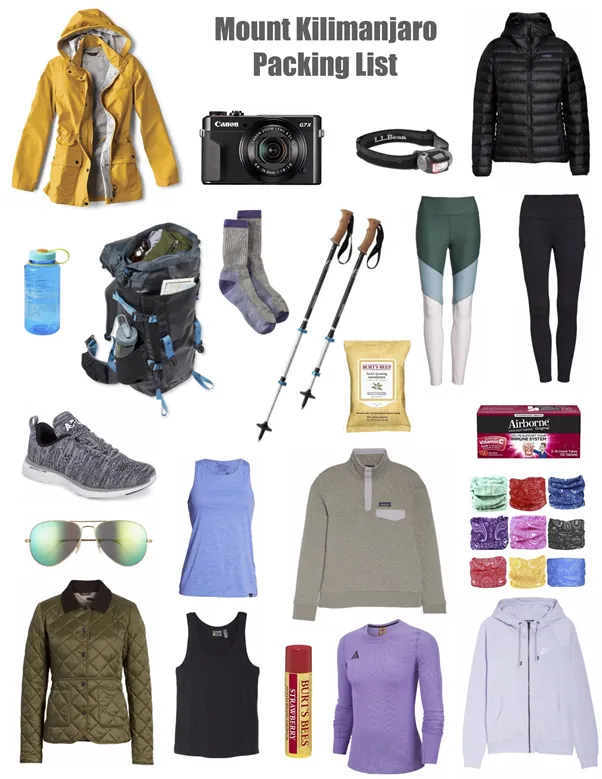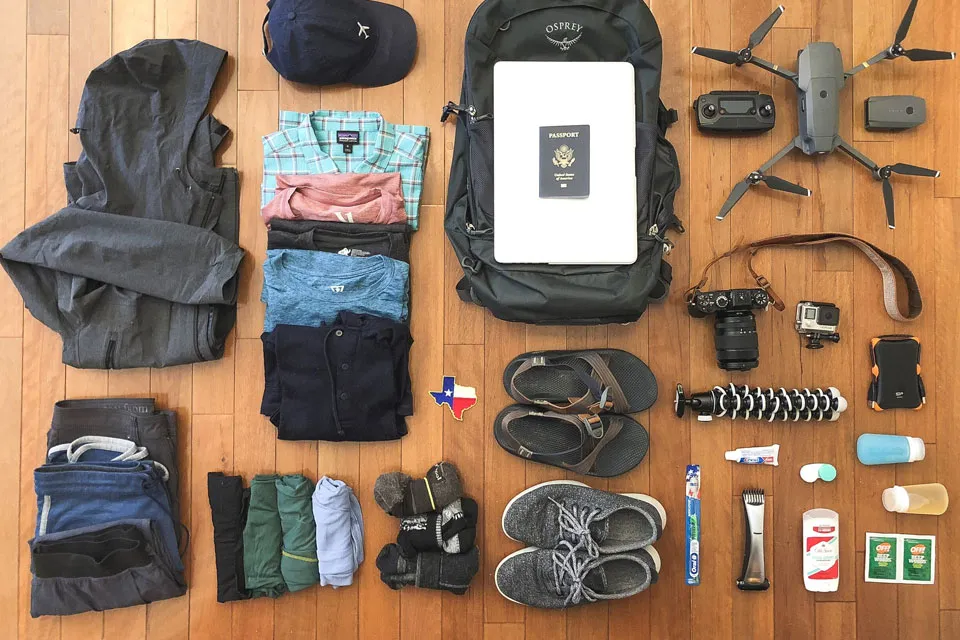Clothing for Your Kilimanjaro Climb
Kilimanjaro’s climate ranges from hot (30°C/86°F) at the base to freezing (-10°C/14°F) at the summit. Layering is key for comfort and safety. Aim for lightweight, moisture-wicking fabrics and a total clothing weight of ~5-6kg.
- Base Layers (2-3 sets): Moisture-wicking tops and bottoms (merino wool or synthetic). Weight: ~200g/set.
- Insulating Layers (1-2): Fleece or midweight jacket for warmth. Weight: ~400g each.
- Waterproof Jacket (1): Gore-Tex or similar, with hood. Weight: ~500g.
- Waterproof Pants (1): Lightweight, breathable. Weight: ~300g.
- Hiking Pants (2-3): Durable, quick-dry. Avoid cotton. Weight: ~300g each.
- Down Jacket (1): Warm, packable for summit night. Weight: ~600g.
- Thermal Gloves (1 pair): Insulated, waterproof for summit. Weight: ~150g.
- Beanie or Balaclava (1): Wool or synthetic for warmth. Weight: ~100g.
- Hiking Boots (1 pair): Waterproof, high-ankle, broken-in. Weight: ~1.2kg/pair.
- Socks (4-5 pairs): Wool or synthetic, liner + heavy pairs. Weight: ~80g/pair.
- Gaiters (1 pair): For dust and mud protection. Weight: ~200g.

Kilimanjaro Climbing Gear & Equipment
Quality gear ensures safety and comfort. Porters carry most equipment, but your daypack (5-7kg) should hold daily essentials. Total gear weight: ~3-4kg.
- Daypack (1): 25-35L for water, snacks, and layers. Weight: ~600g.
- Duffel Bag (1): 70-90L, durable, waterproof for porters. Weight: ~1kg.
- Sleeping Bag (1): Rated to -15°C/5°F for summit night. Weight: ~1.5kg.
- Trekking Poles (1 pair): Collapsible, lightweight. Weight: ~500g/pair.
- Headlamp (1): With extra batteries for night trekking. Weight: ~100g.
- Water Bottle/Bladder (2): 3L total capacity (e.g., 2x 1.5L bottles). Weight: ~300g.
- Sunglasses (1): UV-protective, polarized. Weight: ~50g.
- Sunscreen (SPF 50): 100ml tube for high UV exposure. Weight: ~120g.
- Lip Balm (SPF 30): 15g stick for wind protection.
- First Aid Kit: Bandages, blister pads, painkillers, Diamox (for altitude). Weight: ~200g.

Documents & Essentials for Kilimanjaro Climbing
Keep these items secure and accessible for a smooth Kilimanjaro trek.
- Passport: Valid for 6+ months with 2 blank pages.
- Tanzania Visa: e-Visa, apply online (~$50-$100).
- Travel Insurance: Must cover high-altitude trekking and evacuation.
- Vaccination Card: Yellow fever certificate if required.
- Itinerary & Permits: Printed/digital copies of climb bookings.
- Cash: USD for porter tips (~$10-15/porter/day, ~$100 total) and TZS for small purchases.
Packing Tips for Kilimanjaro Beginners
Maximize comfort and summit success with these beginner-focused tips.
- Layer Strategically: Use base, mid, and outer layers to adapt to temperature swings (-10°C to 30°C).
- Test Gear Early: Break in boots and test trekking poles to avoid discomfort.
- Limit Daypack Weight: Keep your daypack under 7kg for easier hiking.
- Waterproof Everything: Use dry bags for gear, especially in wet season (March-May).
- Pack for Altitude: Include Diamox and consult a doctor for altitude sickness prevention.
- Respect Porter Limits: Total duffel bag weight should not exceed 15kg for porter safety.
Frequently Asked Questions
Can I rent gear for Kilimanjaro?
Yes, many operators offer rentals for sleeping bags, trekking poles, and jackets, but check quality and fit beforehand.
How cold is it at the summit?
Summit temperatures can drop to -10°C (14°F) or lower, especially at night. A down jacket and thermal layers are essential.
Do I need trekking poles?
Trekking poles are highly recommended for stability and reducing knee strain, especially on descents.